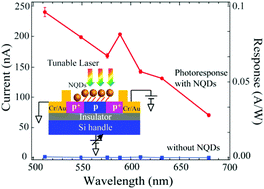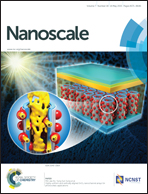Hybrid light sensor based on ultrathin Si nanomembranes sensitized with CdSe/ZnS colloidal nanocrystal quantum dots†
Abstract
We report the observation of a large enhancement of the wavelength-dependent photocurrent in ultrathin silicon nanomembranes (SiNM) decorated with colloidal CdSe/ZnS nanocrystal quantum dots (NQDs). Back-gated, field-effect transistor structures based on 75 nm-thick SiNMs are functionalized with self-assembled monolayers (SAMs) preventing surface oxidation and minimizing the surface defect densities. NQDs are drop cast on the active region of the device and the photocurrent is measured as a function of the excitation wavelength across the NQD absorption region. Photocurrent enhancement on the order of several hundred nA's is observed for NQD/SAM/SiNM devices compared to reference SAM/SiNM structures, with the device peak response closely correlated to the NQD absorption peak. We propose light-induced gating of the surface electrostatic potential and forward self-biasing of the FET channel as the two key mechanisms leading to the large photocurrent increase. Our findings open the possibility of employing silicon-nanocrystal hybrid structures for light sensing applications.


 Please wait while we load your content...
Please wait while we load your content...